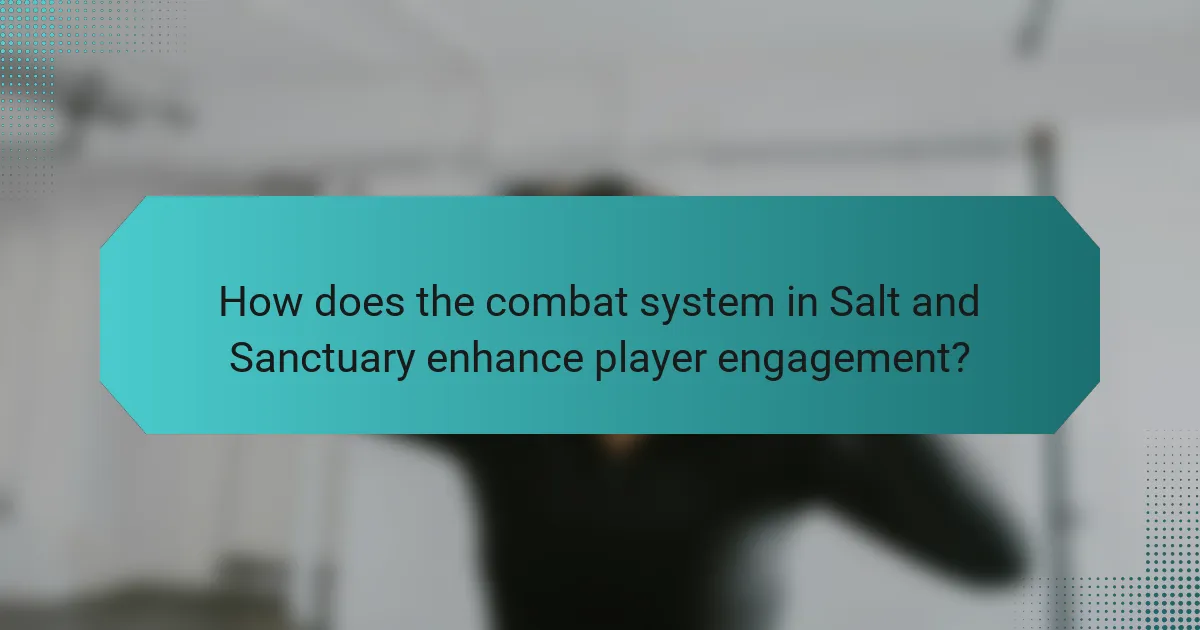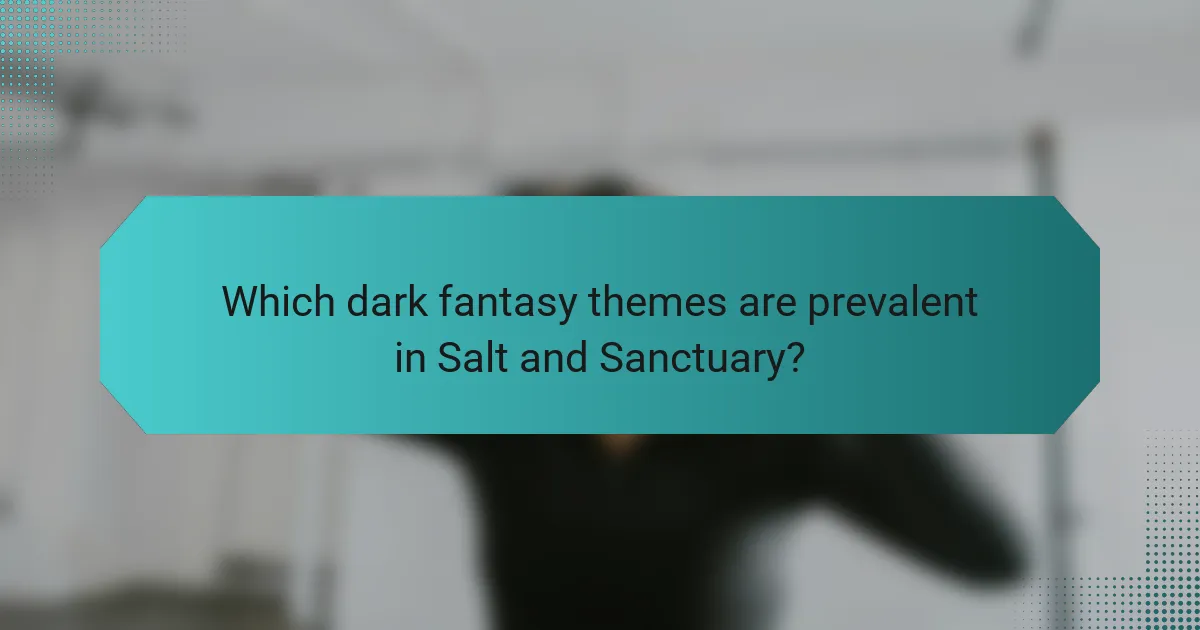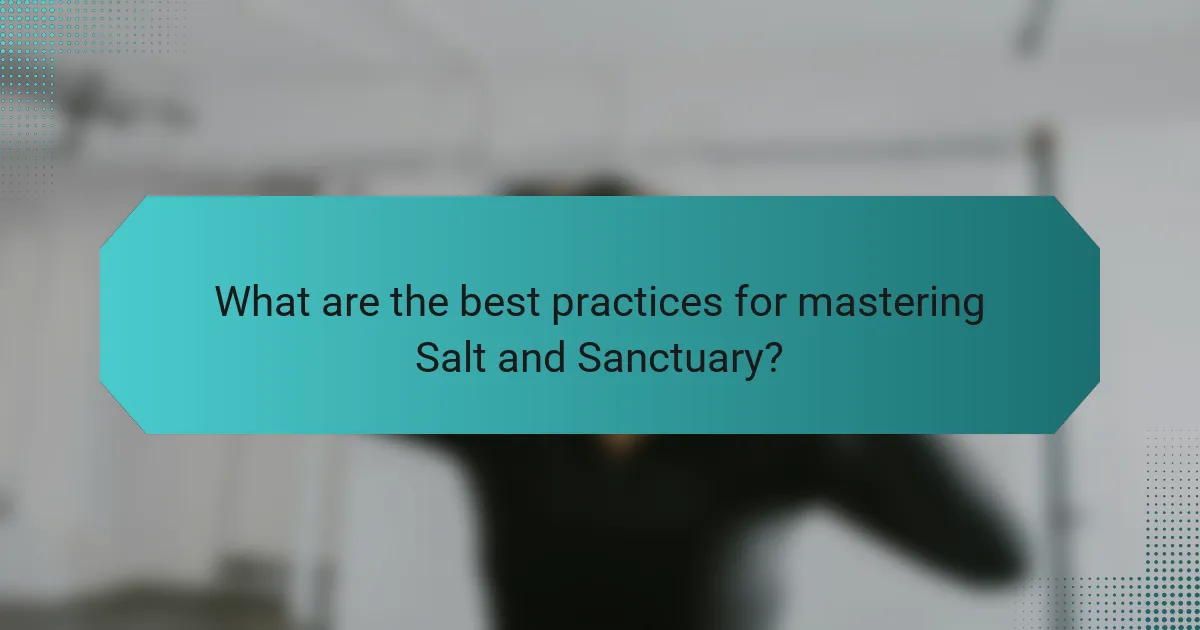Salt and Sanctuary challenges players with its intricate combat system, unique level design, and immersive dark fantasy themes. The combat mechanics require strategic thinking and precise timing. Level design features interconnected environments that promote exploration and discovery. Dark themes of despair and isolation enhance the overall atmosphere, creating a compelling and engaging experience.

How does the combat system in Salt and Sanctuary enhance player engagement?
The combat system in Salt and Sanctuary enhances player engagement through its challenging mechanics and strategic depth. Players face a variety of enemies that require different tactics, fostering a sense of accomplishment. The integration of stamina management adds an extra layer of strategy, compelling players to think critically about their actions. Unique weapon types and customizable builds allow for diverse playstyles, keeping the gameplay fresh and engaging. Additionally, the game’s dark fantasy themes amplify immersion, making each encounter feel significant and impactful.
What are the core mechanics of the combat system?
The core mechanics of the combat system in Salt and Sanctuary emphasize strategic timing and player skill. Players utilize a combination of light and heavy attacks, blocking, and dodging to navigate enemy encounters. The game features a stamina system that limits the number of actions, adding a layer of resource management. Unique attributes include a diverse weapon selection and customizable character builds, allowing players to tailor their combat experience. Rare mechanics such as parrying and weapon special moves enhance combat depth and encourage experimentation.
How do weapon types influence combat strategies?
Weapon types significantly shape combat strategies in Salt and Sanctuary by influencing attack styles, range, and damage output. Each weapon category, such as swords, axes, or spears, presents unique attributes that affect player tactics. For instance, heavier weapons deal more damage but require slower, more deliberate movements, while lighter weapons offer speed and agility. This diversity encourages players to adapt their strategies based on available weaponry, enemy types, and environmental factors. Ultimately, weapon choice enhances the game’s dark fantasy themes by demanding strategic thinking and skillful execution.
What role do character builds play in combat effectiveness?
Character builds significantly influence combat effectiveness in Salt and Sanctuary. Players customize attributes, skills, and equipment to enhance their combat style. Effective builds allow for strategic advantages, such as increased damage output or improved defense. Unique combinations of weapons and abilities can exploit enemy weaknesses, making character builds essential for mastering the game’s challenging encounters.
How does the stamina management system affect gameplay?
The stamina management system significantly impacts gameplay by influencing combat pacing and strategy. Players must balance stamina use during attacks, dodges, and blocks. Effective stamina management enhances survivability and allows for more aggressive playstyles. Conversely, poor stamina management can lead to vulnerability and missed opportunities. This system encourages players to think critically about their actions and adapt to the game’s dark fantasy themes.
Which enemy types challenge the combat system?
Salt and Sanctuary features various enemy types that challenge its combat system, including humanoid foes, beasts, and powerful bosses. Humanoid enemies often employ diverse attack patterns and weapon types, requiring players to adapt their strategies. Beasts present fast and aggressive combat, emphasizing quick reflexes. Bosses serve as significant hurdles, featuring unique mechanics and requiring mastery of the game’s combat system. Each enemy type enhances the game’s dark fantasy theme, contributing to its overall depth and challenge.
What are the benefits of cooperative play in combat?
Cooperative play in combat enhances strategy, communication, and engagement. Players can combine their strengths to tackle challenging enemies and share resources effectively. This teamwork fosters a sense of community and can lead to improved overall performance in battles. Additionally, cooperative play allows for diverse approaches to combat, increasing replayability and enjoyment.
How does the combat system compare to other games in the genre?
The combat system in Salt and Sanctuary is more punishing and methodical compared to other games in the genre. It emphasizes timing and strategy, encouraging players to learn enemy patterns. Unlike many action RPGs, it features a unique blend of 2D platforming and Souls-like mechanics, creating a distinctive experience. The stamina management system requires careful planning, contrasting with some titles that allow for more aggressive playstyles. Overall, Salt and Sanctuary’s combat stands out for its focus on deliberate actions and risk management.

What unique level design elements contribute to the game’s atmosphere?
Unique level design elements in Salt and Sanctuary create an immersive atmosphere through interconnected environments, dark visual aesthetics, and atmospheric soundscapes. The game’s use of verticality enhances exploration, while hidden paths and shortcuts encourage player discovery. Unique attributes like hand-painted backgrounds contribute to the game’s distinct art style, reinforcing its dark fantasy theme. Rare elements, such as environmental storytelling through object placement, deepen the narrative experience, making the world feel alive and interconnected.
How does interconnected world design impact exploration?
Interconnected world design enhances exploration by creating immersive environments that encourage player engagement. In Salt and Sanctuary, the combat system and level design complement dark fantasy themes, promoting discovery through interconnected pathways. Players experience a sense of progression as they navigate through diverse areas, each with unique challenges and lore. This design fosters exploration, rewarding players with hidden items and lore that deepen their understanding of the game world.
What are the key environmental storytelling techniques used?
Salt and Sanctuary employs several key environmental storytelling techniques, including visual cues, atmospheric design, and item descriptions. Visual cues guide players through the world, revealing lore and history through the environment. Atmospheric design uses lighting and sound to evoke emotions and create immersive experiences. Item descriptions provide context and backstory, enhancing the narrative depth. Together, these techniques enrich the dark fantasy themes and level design, creating a cohesive storytelling experience.
How do level layouts facilitate strategic player movement?
Level layouts in Salt and Sanctuary enhance strategic player movement by guiding exploration and combat. The design incorporates verticality and interconnected paths, encouraging players to navigate thoughtfully. Players must consider terrain and enemy placement, fostering tactical decision-making. Unique attributes, like hidden shortcuts, create opportunities for ambushes or escape, enriching gameplay.
What is the significance of shortcuts and secret areas?
Shortcuts and secret areas enhance exploration and strategy in Salt and Sanctuary. They provide players with efficient routes and hidden treasures, enriching gameplay. These elements foster a sense of discovery, rewarding players for their curiosity. Additionally, they contribute to the game’s dark fantasy atmosphere, intertwining level design with combat challenges.
How does the aesthetic of the levels enhance the dark fantasy theme?
The aesthetic of the levels in Salt and Sanctuary significantly enhances the dark fantasy theme by creating an immersive and foreboding atmosphere. Each level features distinct visual elements, such as haunting landscapes and intricate architecture, that evoke a sense of despair and danger. The use of shadowy colors and detailed textures reinforces the grim narrative, drawing players deeper into the game world. Unique attributes, like the contrast between light and dark, amplify the emotional weight of the environment, making exploration both thrilling and unsettling. This design approach effectively immerses players in a cohesive dark fantasy experience.

Which dark fantasy themes are prevalent in Salt and Sanctuary?
Salt and Sanctuary features dark fantasy themes such as despair, isolation, and the struggle against overwhelming odds. The game’s art style and narrative evoke a sense of hopelessness, while its environments often reflect decay and abandonment. Themes of sacrifice and the cyclical nature of life and death are prevalent, enhancing the overall atmosphere. Additionally, the presence of grotesque enemies and haunting lore deepens the dark fantasy experience, immersing players in a world filled with challenges and moral ambiguity.
How do themes of despair and hope manifest in gameplay?
Despair and hope in Salt and Sanctuary manifest through its challenging combat system and atmospheric level design. Players experience despair from difficult enemies and environmental hazards, creating a sense of hopelessness. However, hope emerges through progression, character upgrades, and environmental storytelling. This duality reinforces the game’s dark fantasy themes, making each victory feel significant against the backdrop of adversity. The interplay between these emotions enhances player engagement and immersion.
What narrative techniques are used to convey dark fantasy elements?
Salt and Sanctuary employs narrative techniques like atmospheric world-building, character backstories, and symbolic imagery to convey dark fantasy elements. These techniques immerse players in a haunting environment filled with despair and intrigue. The combat system enhances this experience, showcasing visceral encounters that reflect the game’s themes of struggle and survival. Level design incorporates labyrinthine structures, creating a sense of isolation and danger that complements the overarching dark fantasy narrative.
How do visual and audio design reinforce the dark atmosphere?
Visual and audio design in Salt and Sanctuary creates an immersive dark atmosphere through complementary aesthetics. The hand-drawn art style enhances the foreboding environments, while the haunting soundtrack evokes feelings of dread. Together, they reinforce the game’s themes of isolation and despair. The visual elements, such as shadowy landscapes and grotesque character designs, establish a sense of danger. Meanwhile, the audio cues, including eerie sound effects and unsettling music, heighten tension during combat encounters. This synergy between visual and audio design immerses players deeper into the dark fantasy world.
What cultural influences shape the game’s dark fantasy themes?
Cultural influences such as folklore, mythology, and gothic literature shape the dark fantasy themes in Salt and Sanctuary. The game draws inspiration from various sources, including Japanese role-playing games and Western dark fantasy aesthetics. Elements like despair, isolation, and the struggle against overwhelming odds reflect these cultural narratives. The art style and atmospheric design further enhance the sense of dread, echoing the themes found in classic horror and fantasy literature.

What are the main challenges players face in Salt and Sanctuary?
Players face challenges in Salt and Sanctuary due to its punishing combat system, intricate level design, and pervasive dark fantasy themes. The combat system requires precise timing and strategy, making encounters difficult. Level design features interconnected areas that can confuse players, while dark themes create a relentless atmosphere that heightens tension. These elements combine to create a uniquely challenging experience that tests skill and perseverance.
How do difficulty spikes affect player experience?
Difficulty spikes can enhance player experience by increasing challenge and engagement. In Salt and Sanctuary, these spikes are integral to the combat system and level design. Players face moments that test their skills, creating a sense of accomplishment upon overcoming obstacles. This aligns with dark fantasy themes, where adversity is a core element of the narrative. Balancing difficulty ensures players remain invested, as excessive frustration can lead to disengagement. Thus, well-implemented difficulty spikes contribute positively to the overall gameplay experience.
What common mistakes do players make in combat?
Players often make mistakes in combat by being overly aggressive, neglecting stamina management, and failing to learn enemy patterns. These errors can lead to frequent deaths and hinder progress. Effective combat requires patience, strategic timing, and an understanding of the game’s mechanics. Many players rush into battles without assessing their surroundings or preparing adequately, which can result in missed opportunities for counterattacks.
How can players overcome environmental hazards?
Players can overcome environmental hazards in Salt and Sanctuary by utilizing strategic movement, mastering combat mechanics, and leveraging items. First, players should learn to dodge and roll effectively to avoid traps and enemy attacks. Timing is crucial, as well-timed evasion can prevent damage. Second, understanding the level design helps players anticipate hazards. Familiarizing themselves with the terrain allows for better navigation around pitfalls and ambushes. Third, utilizing consumables like healing items or buffs can enhance survivability in challenging areas. Finally, players should experiment with different weapons and abilities to find effective counters to specific environmental threats.
What strategies can enhance survival in the game?
To enhance survival in Salt and Sanctuary, players should focus on mastering combat mechanics and strategic resource management. Utilize dodge rolling to evade attacks, as timing is crucial for survival. Upgrade weapons and armor to improve defense and damage output.
Exploit the level design by learning enemy placements and ambush points. Use the environment to your advantage, such as leading enemies into traps. Prioritize healing items and manage stamina to maintain offensive and defensive capabilities.
Lastly, explore different character builds to find a playstyle that suits your approach, whether focusing on melee combat, ranged attacks, or magic. Adaptability and preparation are key to thriving in this dark fantasy setting.

What are the best practices for mastering Salt and Sanctuary?
To master Salt and Sanctuary, focus on developing combat skills, understanding level design, and immersing yourself in dark fantasy themes. Prioritize learning enemy patterns to improve timing and strategy. Explore every area thoroughly to uncover secrets and enhance your character’s abilities. Utilize various weapons and spells to adapt to different combat scenarios. Engage with the rich lore to deepen your experience and connection to the game world.
How can players optimize their character builds for success?
Players can optimize their character builds by focusing on specific attributes and playstyles. Prioritizing weapon proficiency enhances combat effectiveness, while investing in health and stamina improves survivability. Choosing the right class and upgrading skills aligned with preferred combat strategies is essential. Experimenting with different builds allows players to discover unique combinations that suit their gameplay. Balancing offense and defense is crucial for success in challenging encounters.
What tips can improve combat efficiency?
To improve combat efficiency in Salt and Sanctuary, focus on mastering timing, weapon choice, and enemy patterns. Prioritize dodging and blocking to mitigate damage. Utilize the environment strategically for positioning. Upgrade equipment to enhance attributes like damage and speed. Experiment with different builds to find the most effective playstyle.
How should players approach level exploration for maximum rewards?
Players should explore levels methodically, focusing on hidden areas and combat opportunities for optimal rewards. Engaging with enemies not only enhances skill but also yields valuable resources.
Utilizing the combat system effectively can reveal shortcuts and secrets. Players should prioritize exploring off the main path to uncover unique items and lore.
Pay attention to environmental cues that may indicate hidden passages or traps. Mastering the timing of attacks and dodges increases survival chances, allowing for deeper exploration.
Lastly, revisiting previously cleared areas can unveil new rewards as players gain abilities and items, enriching the overall experience.
What resources are available for further learning and community engagement?
Numerous resources exist for further learning and community engagement related to Salt and Sanctuary. Online forums and social media groups foster discussions on combat strategies and level design. Game wikis provide detailed insights into dark fantasy themes and mechanics. YouTube channels offer tutorials and gameplay analysis. Additionally, official game websites and fan sites feature updates and community events. Engaging with these platforms enhances understanding and connection with fellow enthusiasts.